aug . 10, 2025 03:00 Back to list
High Efficiency Multi Head Embroidery Machines | Flat & T-Shirt
The Evolution and Impact of Multi-Head Embroidery Machines in Modern Textile Production
In the dynamic landscape of textile and apparel manufacturing, the demand for efficiency, precision, and versatility has never been more pronounced. At the forefront of meeting these rigorous requirements stands the multi head embroidery machine, a pivotal innovation transforming industrial embroidery. This sophisticated equipment allows for the simultaneous production of multiple identical or varied designs, drastically increasing output while maintaining impeccable quality. Unlike single-head machines, which are suitable for bespoke or small-batch orders, multi-head systems are engineered for mass production, making them indispensable for large-scale apparel factories, promotional product suppliers, and custom design houses. Their capacity to handle diverse materials, from delicate silks to robust denim, and to execute intricate designs with high stitch counts, positions them as central to modern high-volume embroidery operations. The shift towards automated and high-speed solutions is driven by market pressures for quicker turnaround times, lower production costs, and consistent product excellence, areas where these advanced machines demonstrably excel. The continuous innovation in control systems, motor technology, and automated features further solidifies their role as the backbone of efficient, high-quality embroidery.
The technological advancements integrated into these machines, such as advanced servo motors for precise movement, intuitive touch-screen interfaces for seamless operation, and sophisticated software for design management, underscore their pivotal role. Modern multi head embroidery machines are not merely tools for stitching; they are complex, integrated systems that optimize the entire embroidery workflow. They significantly reduce the human intervention required, from automatic thread trimming and color changes to real-time stitch monitoring, leading to fewer errors and higher productivity. The ability to integrate with various Computer-Aided Design (CAD) and Manufacturing (CAM) systems allows for rapid prototyping and production, adapting swiftly to changing market trends and customer demands. This adaptability is crucial in an industry characterized by fast-changing fashion cycles and personalized customization trends. Furthermore, the robust construction and advanced componentry ensure a long operational lifespan, providing a high return on investment for businesses. The reliability and consistency offered by these machines are paramount in maintaining brand reputation and meeting stringent client specifications in a competitive global market. This comprehensive capability makes the multi head embroidery machine a cornerstone of modern manufacturing excellence, enabling businesses to scale operations and diversify product offerings with confidence and unparalleled efficiency.
Unveiling the Manufacturing Prowess: The Anatomy and Production of a High-Speed Multi-Head Embroidery Machine
The creation of a high-speed multi head embroidery machine is a meticulous process demanding precision engineering, robust material selection, and rigorous quality control at every stage. It begins with advanced CAD/CAM design, where engineers conceptualize the machine's core structure, motion systems, and electronic architecture. This digital blueprint ensures optimal performance, durability, and ergonomic design. The choice of materials is critical: high-grade steel, often derived from certified sources, is selected for the main frame and structural components, providing the necessary rigidity and stability to withstand continuous high-speed operation. Precision-machined aluminum alloys are utilized for moving parts like the pantograph and specific head components to reduce inertia and improve speed, while specialized hardened steel is used for shafts, gears, and needle bars to ensure minimal wear and extended service life. Each material selection is rigorously tested for its mechanical properties, including tensile strength, hardness, and fatigue resistance, often adhering to international standards like ASTM or EN.
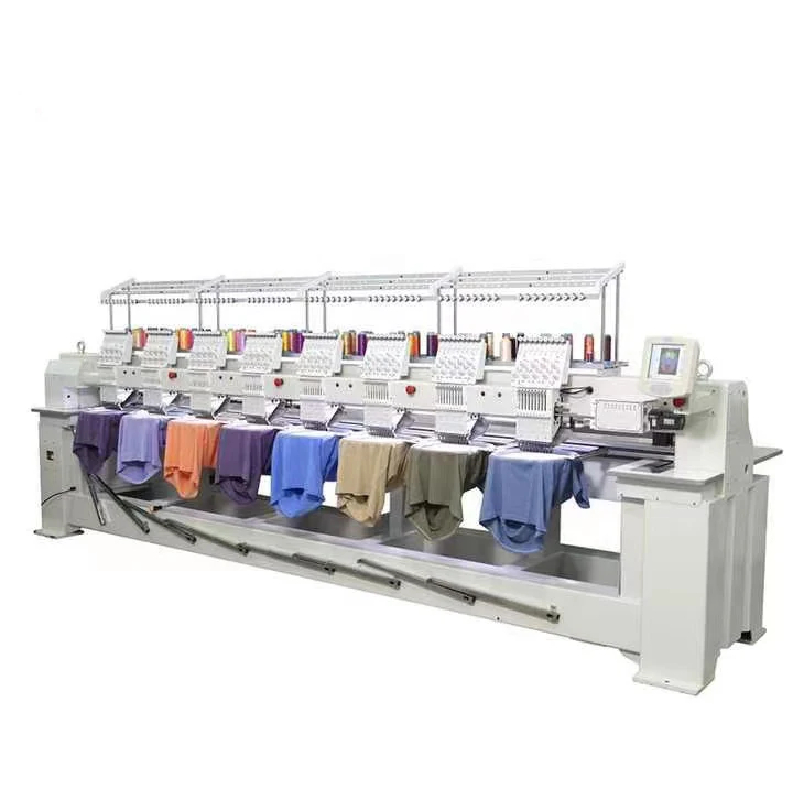
The manufacturing process incorporates a range of advanced techniques. Frame fabrication often involves laser cutting for high precision, followed by robotic welding to ensure strong and consistent joints, preventing distortion under stress. Critical components undergo Computer Numerical Control (CNC) machining, a process that achieves sub-millimeter tolerances, vital for the smooth and synchronized operation of multiple embroidery heads. This includes the intricate components of each head mechanism, the precision shafts that drive the needle bars, and the complex cam mechanisms responsible for thread take-up and trimming. Heat treatment processes, such as tempering and nitriding, are applied to critical steel parts to enhance surface hardness and wear resistance, significantly extending their operational lifespan. Surface treatments like powder coating are applied to the frame not only for aesthetic appeal but also to provide corrosion resistance, protecting the machine in various industrial environments. The integration of high-quality electronics, including servo motors (known for their precise control and energy efficiency) and advanced control boards, is performed in cleanroom environments to prevent contamination. Each motor, sensor, and circuit board is individually tested before assembly to ensure flawless functionality, contributing to the machine's overall reliability and performance.
Quality control is paramount throughout the entire manufacturing journey. From the initial raw material inspection, where spectrographic analysis verifies material composition, to in-process checks using Coordinate Measuring Machines (CMM) for dimensional accuracy of machined parts, every stage is meticulously monitored. Sub-assembly testing verifies the functionality of individual modules like the thread trimming system or color change mechanism. Upon final assembly, each multi head embroidery machine undergoes rigorous performance testing. This includes extended high-speed operation durability tests, precise stitch quality and registration accuracy checks across the entire embroidery field, and noise and vibration analysis to ensure smooth operation. Electrical safety and Electromagnetic Compatibility (EMC) tests are conducted to ensure compliance with international standards such as CE (European Conformity) and potentially UL or FCC, guaranteeing operational safety and minimizing electromagnetic interference. Software validation ensures that the user interface is intuitive, design loading is seamless, and all parameters are precisely controllable. These comprehensive testing protocols, often guided by ISO 9001 quality management systems, ensure that each machine delivered meets the highest standards of reliability, precision, and longevity, typically offering an operational lifespan of 10-15 years or more with proper maintenance, making them a significant long-term asset for businesses in apparel, promotional products, home textiles, and automotive interiors.
Technical Parameters and Performance Benchmarks: A Deep Dive into Multi-Head Embroidery Machines
Understanding the technical parameters of a multi head embroidery machine is crucial for making an informed investment decision. These specifications directly impact production capacity, versatility, and the quality of the final embroidered product. Key parameters include the number of heads, typically ranging from 2 to 24 or even more, with each head operating independently to maximize concurrent output. The number of needles per head, commonly 9, 12, or 15, determines the range of colors available in a single design without manual thread changes, with 15-needle machines offering superior color flexibility. Stitch speed, measured in stitches per minute (SPM), is a critical performance indicator, with high-speed models reaching up to 1200-1500 SPM, directly translating to higher hourly production. The embroidery area or field size specifies the maximum dimensions of a design that can be stitched on flat goods, tubular items, or caps, often ranging from 400x450mm to larger formats for specialized applications. Moreover, the type of drive system—whether advanced AC servo motors or precision stepper motors—influences the accuracy, speed, and energy efficiency of the machine's X and Y axis movement, essential for consistent stitch quality, especially on intricate designs.
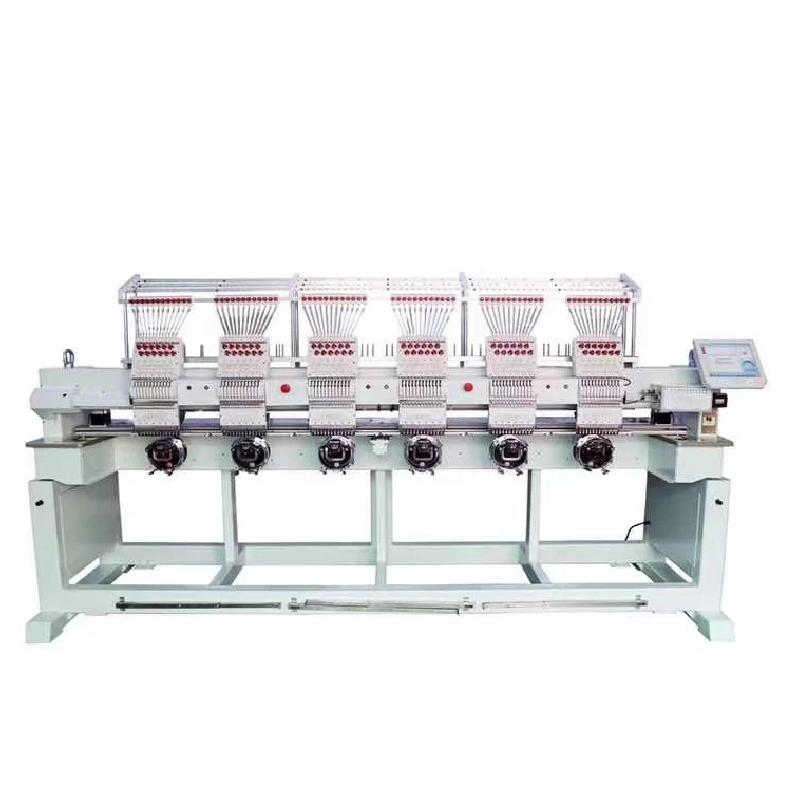
Control systems are another vital technical aspect. Modern multi head embroidery machines feature intuitive touch-screen LCD displays, often 10 inches or larger, providing easy access to design management, machine settings, and real-time operational feedback. Connectivity options, including USB ports for design transfer and Ethernet for networking multiple machines or integrating with production management software, are standard. Memory capacity, measured in stitches, indicates how many designs or how large a single design the machine can store internally, with modern machines capable of storing millions of stitches. Automated features such as automatic thread trimming, automatic color change, and thread break detection significantly reduce downtime and human error. Specialized attachments and capabilities, including sequin devices for adding decorative embellishments, cording devices for dimensional designs, and chenille devices for loop or chain stitches, extend the machine's versatility beyond standard flat embroidery, enabling the creation of complex and high-value textiles. The frame drive system, often a robust linear guide rail system, ensures smooth and precise movement of the pantograph, critical for maintaining stitch registration across large embroidery fields and at high speeds, while minimizing vibration. The integration of advanced software for digitizing and managing designs, compatible with industry-standard formats like .DST (Tajima) and .EMB (Wilcom), ensures seamless workflow from design concept to final product, enhancing overall operational efficiency.
Below is a comparative table highlighting typical specifications for High Speed Multi Head Embroidery Machines, such as the High speed Multi head embroidery machine t-shirt flat hat computer embroidery machine for sale, which demonstrates a blend of high performance and versatility suitable for a wide array of production needs. These parameters are often optimized for speed, precision, and durability, catering to industrial environments requiring continuous operation. Understanding these metrics enables businesses to align machine capabilities with their specific production demands, ensuring optimal efficiency and return on investment. The inclusion of features like a network port allows for centralized control and monitoring of multiple machines, optimizing production scheduling and minimizing manual intervention. Furthermore, sophisticated error detection systems, such as thread break sensors and bobbin-end sensors, contribute significantly to uninterrupted production, reducing material waste and operator oversight, thereby enhancing overall operational trustworthiness and efficiency.
| Parameter | Description | Typical Range/Value |
|---|---|---|
| Number of Heads | Simultaneous embroidery units operating independently. | 2 to 24 (or more) |
| Number of Needles/Head | Available thread colors per head without manual change. | 9, 12, 15 (most common) |
| Max. Stitch Speed | Stitches Per Minute (SPM). | 1000 - 1500 SPM |
| Embroidery Area (Flat) | Maximum design size on flat goods. | 400x450mm, 500x800mm (per head) |
| Embroidery Area (Cap) | Maximum design size on caps. | 70x270mm to 80x360mm |
| Main Motor | Powers the main drive system. | Servo Motor (e.g., DAHAO, Panasonic) |
| X/Y Motor | Drives pantograph movement. | Servo Motor or Stepper Motor |
| Control System | Operating system and display. | 10" HD LCD Touch Screen (e.g., DAHAO A15) |
| Memory Capacity | Stitch count or design storage. | 20-200 Million Stitches (up to 2000 designs) |
| Data Input | Methods for transferring designs. | USB, Ethernet/LAN |
| Automated Features | Functions for efficiency. | Auto Thread Trimming, Auto Color Change, Thread Break Detection, Power Failure Protection |
| Power Requirements | Electrical specifications. | 220V/380V, 50/60Hz, 1.5-4kW |
| Net Weight | Machine weight without packaging. | 600kg - 3000kg+ (Varies by heads/size) |
Application Scenarios and Industry Impact: Versatility in Action
The versatility of a multi head embroidery machine makes it an invaluable asset across a broad spectrum of industries, extending far beyond traditional apparel manufacturing. In the highly competitive apparel sector, these machines are essential for producing large volumes of embroidered garments, from t-shirts and polo shirts to jackets and caps. Their high speed and consistency ensure uniform branding across product lines, crucial for maintaining brand integrity for both fashion brands and uniform suppliers. For instance, a leading sportswear manufacturer might utilize a 12-head multi head embroidery machine with a 15-needle configuration to rapidly produce thousands of branded jerseys daily, achieving complex logos with numerous colors while maintaining precise registration, even on challenging performance fabrics. This capability is paramount for meeting tight production deadlines during peak seasons or for special events, demonstrating the immediate commercial impact of such machinery. The transition between different garment types, such as from flat embroidery on a jacket back to tubular embroidery on sleeves or caps, is seamless due to interchangeable hooping systems, maximizing machine utilization.
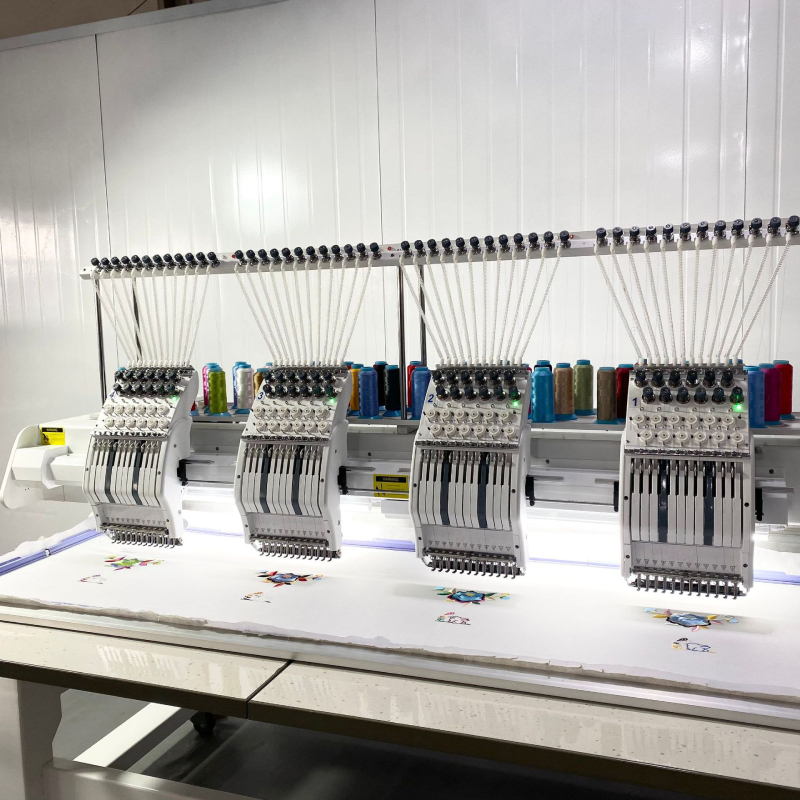
Beyond apparel, the promotional products industry heavily relies on multi head embroidery machines for customizing corporate merchandise, hats, bags, and various promotional giveaways. The ability to handle diverse materials and apply intricate branding ensures that companies can effectively extend their visual identity onto a wide range of items. Imagine a promotional company fulfilling an order for 5,000 embroidered caps for a corporate event; a multi-head machine drastically reduces the production time compared to single-head units, ensuring timely delivery and cost-effectiveness. The education sector also benefits, with universities and schools using these machines to create branded uniforms, sports team apparel, and club merchandise, often requiring customization for individual students or teams. Furthermore, in the realm of home textiles, these machines are employed to embellish bed linens, towels, and decorative pillows, adding a touch of luxury and personalized design to consumer goods. The efficiency gained by simultaneously embroidering multiple items or multiple parts of a single item, such as different panels of a custom shoe, significantly reduces labor costs and accelerates time to market, proving the transformative economic advantages of these advanced systems across various manufacturing sectors.
The automotive industry increasingly utilizes industrial embroidery for interior components, such as custom floor mats, seat covers, and headrests, where precision and durability are paramount. The ability to embroider complex logos or patterns directly onto these materials with industrial-grade quality ensures longevity and enhances vehicle aesthetics. For small to medium-sized businesses (SMBs) specializing in custom embroidery or personalization, a computerized t shirt embroidery machine with multiple heads allows them to scale production without compromising on bespoke quality, moving from limited runs to more substantial orders efficiently. This is particularly true for businesses focused on customized sports team uniforms or niche fashion lines where unique, high-quality embroidery is a distinguishing factor. The efficiency and consistency provided by these machines also extend to sectors requiring specialized textiles, such as medical uniforms or workwear, where branding and specific functional embellishments are necessary. Their robust build and ability to operate continuously, often with minimal operator intervention thanks to features like automatic oiling systems and sophisticated error detection, contribute to higher uptime and reduced operational overhead, proving their economic viability and indispensable role in a diverse range of industrial and commercial applications.
Technological Superiority: Advantages of Advanced Multi-Head Systems
The technological advantages of modern multi head embroidery machines are manifold, contributing directly to enhanced productivity, superior quality, and operational efficiency. Firstly, the most apparent advantage is unparalleled production capacity. By enabling simultaneous embroidery on multiple garments or items, these machines dramatically reduce per-unit production time, allowing businesses to meet large orders quickly and effectively. For example, a single operator can manage 10 or more heads producing intricate designs concurrently, a task that would require numerous single-head machines and operators, highlighting the significant labor cost savings and increased throughput. This scales up production linearly with the number of heads, making the investment highly attractive for growth-oriented enterprises. Secondly, consistency and precision are hallmark features. Advanced computer control systems, often driven by sophisticated DAHAO or similar industrial controllers, ensure that every stitch across all heads is identical in quality, tension, and placement. This eliminates human variability and guarantees uniform branding or design execution across an entire production run, which is critical for corporate clients and high-end fashion brands where brand integrity is paramount.
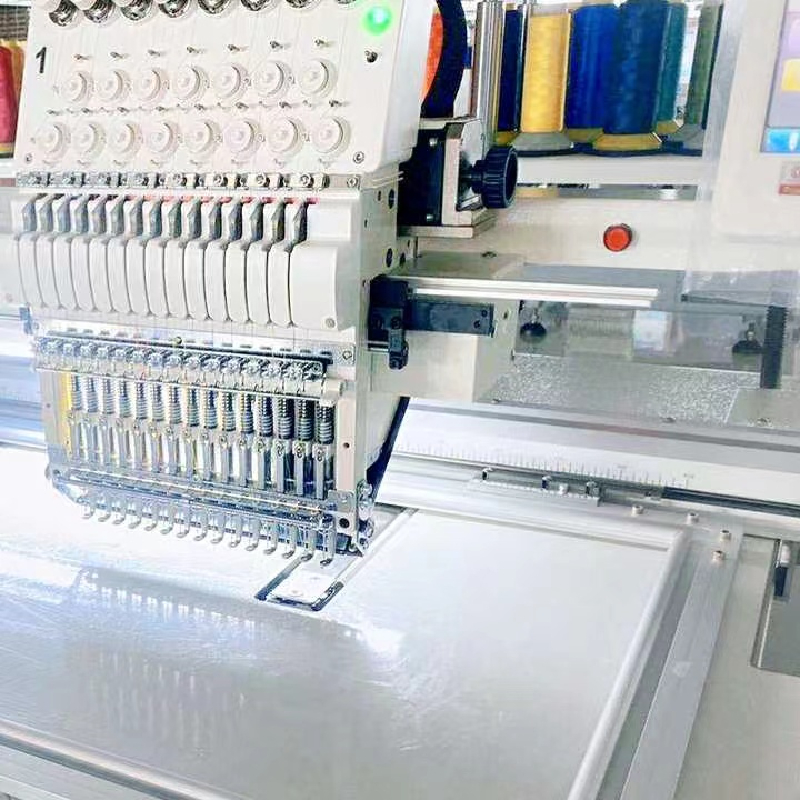
Thirdly, modern multi head embroidery machines offer remarkable versatility. Equipped with interchangeable hooping systems, they can seamlessly transition between flat embroidery (for fabric panels, patches), tubular embroidery (for t-shirts, polo shirts, sleeves), and cap embroidery, accommodating a wide range of product types without significant downtime for changeovers. This adaptability allows businesses to diversify their product offerings and respond to diverse market demands without needing separate specialized machines. The integration of high-speed servo motors for the main drive and X/Y axis ensures not only rapid movement but also extreme accuracy, even at speeds exceeding 1200 SPM. Unlike older stepper motor systems, servo motors provide precise feedback control, virtually eliminating skipped stitches or misalignments, even during complex design segments. Furthermore, automated features such as automatic thread trimming, intelligent thread break detection, and automatic color change systems minimize manual intervention, reduce material waste, and increase overall machine uptime, leading to more cost-effective operations and higher profitability for the end-user. The intuitive touch-screen interfaces, often featuring multi-language support and easy design loading via USB or network, streamline the operational workflow and reduce the learning curve for operators, enhancing overall user experience and productivity.
Energy efficiency is another significant advantage, particularly with the adoption of energy-saving servo motors which consume less power compared to traditional AC motors, contributing to lower operational costs and a reduced carbon footprint, an increasingly important consideration for environmentally conscious businesses. The robust construction, utilizing high-grade steel and precision-machined components, ensures a long operational lifespan and minimal maintenance requirements, leading to reduced total cost of ownership over time. The integration with advanced digitizing software allows for complex design creation and optimization, ensuring that the machine translates intricate digital designs into perfect physical embroidery. Additionally, many contemporary models include features like power failure protection, which automatically saves the current stitch point, allowing for seamless resumption of work after a power interruption, preventing costly material waste and production delays. This level of reliability and automation makes the flat embroidery machine a superior choice for industrial-scale operations seeking to maximize output, ensure consistent quality, and achieve a competitive edge in the global textile market, solidifying its position as an indispensable tool for modern, efficient production.
Manufacturer Comparison and Customization Solutions
When investing in a multi head embroidery machine, potential buyers often weigh options from global leaders like Tajima, Barudan, and Happy, alongside emerging high-value manufacturers. While established brands offer proven reliability and extensive global support networks, they typically come with a premium price tag. Manufacturers like xtpfsm.com, offering products such as the "High speed Multi head embroidery machine t-shirt flat hat computer embroidery machine for sale," often position themselves as highly competitive alternatives. They frequently integrate the same core components (e.g., DAHAO control systems, Japanese-made servo motors, Italian belts) as the top-tier brands, but offer them at a more accessible price point, providing an excellent value proposition for businesses seeking high performance without the substantial upfront capital expenditure. Key differentiating factors often include the depth of localized technical support, warranty periods, spare parts availability, and the degree of customization offered for specific production needs. While Tajima might be renowned for its proprietary software and intricate machine mechanics, an alternative like our featured product aims to democratize high-speed, multi-head capabilities by combining robust, industry-standard components with streamlined manufacturing processes, ensuring competitive pricing and consistent quality. This approach allows a broader range of businesses, including growing SMEs, to access industrial-grade embroidery solutions, empowering them to scale their operations and compete effectively in the global market.
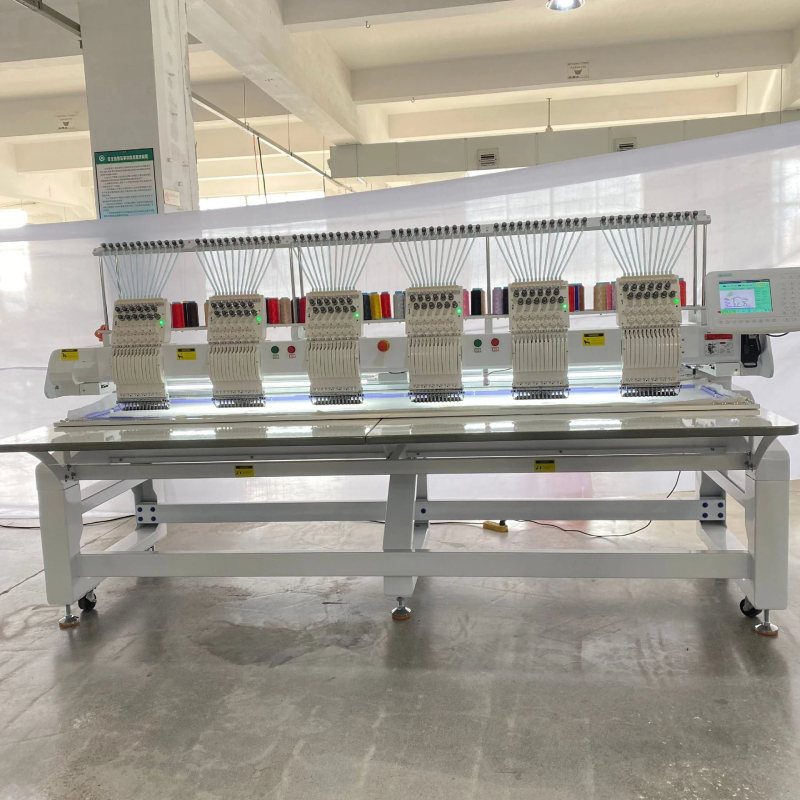
Customization solutions are increasingly crucial for businesses with unique production demands. Leading manufacturers understand that a one-size-fits-all approach is often insufficient for industrial applications. Therefore, they offer various options to tailor a multi head embroidery machine to specific requirements. This can include varying the number of heads (e.g., from 2 to 24), customizing the embroidery field size to accommodate oversized items like banners or large textile panels, or integrating specialized attachments such as sequin devices for added embellishment, cording devices for rope-like textures, or chenille heads for raised, fuzzy designs. Some manufacturers also provide options for specialized frame types, such as robust pneumatic clamps for rigid materials or cylindrical frames for unusual tubular items, ensuring optimal fabric handling. The control system itself can sometimes be customized with specific software modules for production management or integration with existing ERP systems, optimizing workflow and data exchange. Furthermore, voltage and power requirements can be adapted to specific regional electrical standards, ensuring seamless integration into diverse manufacturing facilities worldwide.
For businesses requiring a flat embroidery machine or a specialized computerized t shirt embroidery machine, customization extends to specific frame types and software optimizations for garment handling. For example, a supplier focusing solely on t-shirt production might prioritize machines with automated garment loading systems or specific platen designs that facilitate rapid hooping. Customization can also encompass enhanced safety features, specialized lighting for improved visibility, or even modifications to the machine's physical footprint to fit within space-constrained factories. The ability to consult with manufacturers on specific needs and receive tailored configurations significantly enhances the machine's value proposition and operational efficiency, ensuring that the investment precisely matches the unique demands of a business, thereby maximizing return on investment and facilitating smooth, high-volume, and high-quality production, establishing a trustworthy partnership between the client and the machine provider. This flexibility ensures that the machine is not just a piece of equipment, but a highly optimized solution for specific production challenges.
Real-World Impact: Application Cases and Customer Success
The tangible benefits of investing in a high-quality multi head embroidery machine are best illustrated through real-world application cases and documented customer successes. Consider a large-scale apparel manufacturer that needed to increase its production capacity for corporate uniforms by 40% within six months to meet new contract demands. By replacing several older, less efficient single-head machines with a fleet of 10-head, 15-needle multi-head machines, they were able to not only meet but exceed this target. Their production throughput for embroidered polo shirts, each featuring a detailed company logo, surged from 500 units per day to over 2,500 units per day with the same number of operators, dramatically reducing labor costs per unit. The consistency in stitch quality across all 20 heads operating simultaneously ensured brand uniformity, leading to higher client satisfaction and securing future contracts. This specific case highlights the machine's capability in delivering substantial increases in volume while maintaining rigorous quality control, a critical factor for businesses handling high-value contracts. The ease of design transfer via network connectivity and the intuitive control system meant that operators were quickly trained and able to maximize machine uptime, contributing directly to this significant operational enhancement and showcasing true expertise.
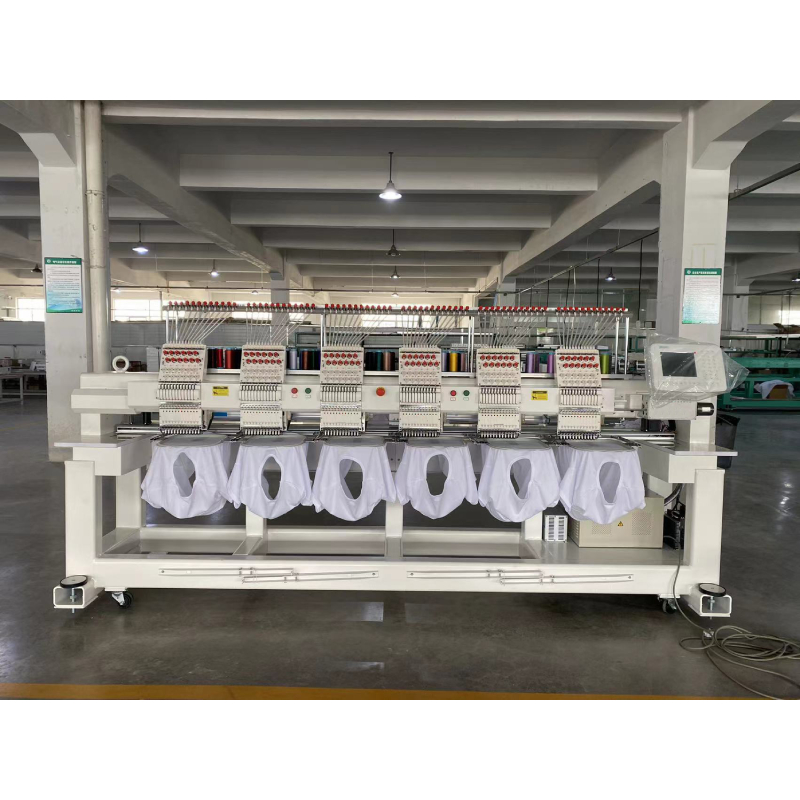
Another compelling example comes from a burgeoning promotional products company specializing in custom hats and bags. Faced with escalating demand for personalized items and a need to reduce outsourcing costs, they invested in a 6-head multi head embroidery machine with cap and tubular attachments. Previously, fulfilling an order of 1,000 custom-embroidered caps would take a week using single-head machines, requiring extensive manual intervention. With the new multi-head system, this same order could be completed in just two days, primarily due to the synchronized operation of six heads and automated features like thread trimming and color change. This acceleration in production allowed them to accept more orders, significantly expand their client base, and improve profit margins by bringing production in-house. The machine's ability to seamlessly switch between cap and flat embroidery further enhanced their operational flexibility, enabling them to tackle diverse product types without dedicated machinery for each, demonstrating a strong return on experience. The robust build quality and reliability of the machine meant fewer breakdowns, minimizing costly interruptions and ensuring predictable delivery schedules, strengthening client trust and cementing their market position.
A third noteworthy case involves a bespoke fashion house known for its intricate textile embellishments. They integrated a specialized flat embroidery machine featuring sequin and cording devices into their workflow. This allowed them to produce highly complex, multi-textured designs on high-end garments and accessories, something previously only achievable through laborious manual application or specialized outsourcing. The precision of the machine in integrating sequins and cords seamlessly with traditional embroidery stitches opened up new design possibilities and elevated the perceived value of their products. This not only attracted a more exclusive clientele but also streamlined their design-to-production cycle for these complex items, significantly reducing lead times. The authority provided by owning such advanced capabilities, combined with the proven track record of reliable performance and excellent after-sales support, reinforces the trust placed in these sophisticated machines. These case studies underscore that the investment in a state-of-the-art multi head embroidery machine is not just about acquiring equipment; it's about acquiring a strategic advantage that drives efficiency, expands capabilities, and ultimately fuels business growth and profitability across various industrial applications, from high-volume apparel to niche, high-value fashion and promotional goods.
Ensuring Trustworthiness: FAQ, Delivery, Warranty, and Support
For B2B buyers considering a significant investment in a multi head embroidery machine, trustworthiness is built not just on product specifications, but also on comprehensive support, clear commitments, and transparent communication. A robust FAQ section addresses common queries proactively, covering topics from machine setup and operation to maintenance best practices and troubleshooting. For instance, frequently asked questions might include: "What is the typical lifespan of a multi head embroidery machine?" (Typically 10-15 years with proper maintenance); "What are the power requirements?" (Usually 220V/380V, 50/60Hz, depending on model); "What file formats does the machine support?" (Commonly DST, EMB, and other industry standards); and "How often does the machine require maintenance?" (Varies by usage, but typically daily checks, weekly lubrication, and annual professional servicing). Such clarity instills confidence and demonstrates expertise in anticipating client needs. Furthermore, transparency regarding the manufacturing process, adherence to international quality standards such as ISO 9001:2015, and certifications like CE mark for European markets, provide an authoritative stamp of quality and safety. This meticulous attention to detail from the initial design phase through to final assembly and testing underpins the reliability of the product.

Delivery timelines and processes are crucial for operational planning. A typical delivery cycle for a high-speed multi head embroidery machine from order confirmation to shipment might range from 30 to 60 days, depending on customization requirements and current production schedules. Reputable manufacturers provide detailed updates throughout the production and shipping phases, including tracking information for international freight. Packaging methods are designed to protect the machinery during transit, often involving robust wooden crates and anti-corrosion wraps, ensuring the machine arrives in pristine condition, ready for installation. Upon arrival, professional installation and commissioning services are frequently offered, either by in-house technicians or certified partners, ensuring that the machine is set up correctly and integrated seamlessly into the client's production environment. This hands-on experience by certified technicians provides immediate support and optimizes initial performance.
Warranty and after-sales support are perhaps the most significant indicators of a manufacturer's trustworthiness. A standard warranty for a computerized t shirt embroidery machine typically covers 1 to 2 years for major mechanical and electrical components, with dedicated support for the lifespan of the machine. Comprehensive customer support includes multi-channel access (phone, email, online ticketing), readily available spare parts, and remote diagnostic capabilities for rapid troubleshooting. Many manufacturers also offer virtual or on-site training programs for operators and maintenance staff, empowering clients to maximize the machine's potential and perform routine maintenance effectively. For a product like the "High speed Multi head embroidery machine t-shirt flat hat computer embroidery machine for sale," the commitment to continuous support and accessible technical assistance ensures minimal downtime and a high return on investment for the customer. This holistic approach to customer care, from transparent communication to robust technical assistance and warranty pledges, solidifies the manufacturer's authority and builds enduring trust, making them a reliable partner in the demanding world of industrial textile production.
References and Further Reading
- Textile World Magazine - Industry Trends and Technology Updates. Available at: https://www.textileworld.com/
- International Textile Manufacturers Federation (ITMF) - Statistical Reports and Publications. Available at: https://www.itmf.org/
- Journal of Textile Engineering - Research on Embroidery Automation and Material Science. (Access via academic databases, e.g., ScienceDirect or IEEE Xplore for specific papers).
- European Standard EN ISO 9001:2015 - Quality management systems. (Reference for quality control standards in manufacturing).
- CE Marking for Machinery Directive 2006/42/EC - Compliance and Safety Standards. (General reference for industrial machinery certification).
-
High Efficiency Multi Head Embroidery Machines | Flat & T-Shirt
NewsAug.10,2025
-
Computerized T-Shirt Embroidery Machines: Flat & Affordable
NewsAug.09,2025
-
Cheap Computer Embroidery Machine Price: Pro & Cap Models
NewsAug.08,2025
-
Professional Embroidery Machine: Precision & Performance
NewsAug.07,2025
-
T Shirt Embroidery Machine | Multi-Head, 12 & 15 Needle
NewsAug.06,2025
-
Best Industrial Embroidery Machines For Sale | AI Tech
NewsAug.03,2025

Copyright © 2025 Xingtai Pufa Trading Co., Ltd All Rights Reserved. Sitemap | Privacy Policy
